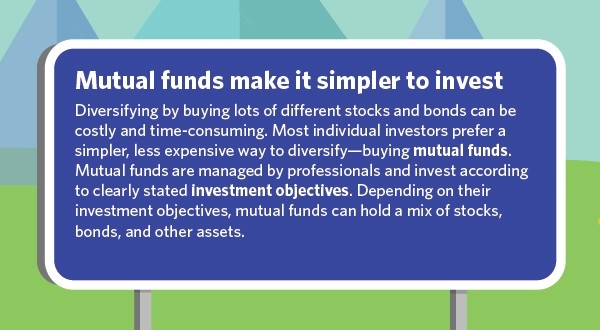ICI Viewpoints
Investing Basics: The Benefits of Mutual Funds

As part of the ICI Education Foundation’s 30th anniversary celebration, we are sharing a series of ICI Viewpoints explaining basic investing concepts, drawn from the ICI Education Foundation’s Investing Road Trip.
We’ve reached the halfway point in this series, and we’ve covered a lot of ground: the benefits of investing, how to think about risk, different types of investments, why diversification is important, and dollar-cost averaging. This month’s installment on mutual funds brings all these topics together.

A mutual fund is an investment company that pools money from shareholders and invests in a portfolio of securities (like stocks and bonds). More than 100 million shareholders in the United States own mutual funds, relying on them to meet long-term personal financial objectives, such as preparing for retirement, saving for education, purchasing a house, or preparing for emergencies.
The following seven features explain what mutual funds offer—and why they’re an enduringly popular investment choice—for investors.
Professional Management
A mutual fund’s portfolio can be actively managed, in which a professional investment adviser creates a unique mix of investments, or passively managed, in which the adviser seeks to track the performance of a selected benchmark or index. In either case, the fund pursues a particular investment objective—for example, investing in stocks of small US-based companies, or in bonds from emerging markets. A fund’s investment objective is clearly spelled out in its prospectus, which is the document a fund company is required to disclose and make available to investors and prospective investors.
Declining Costs
A mutual fund may manage dozens or even hundreds of securities on behalf of its shareholders, and it charges shareholders for ongoing operating costs, such as fund management, recordkeeping, shareholder services, and legal and accounting expenses. The sum of operating expenses over the course of a year is expressed as a percentage of the fund’s average net assets (the expense ratio) and disclosed in a standardized fee table in the fund prospectus. The prospectus also discloses shareholder fees that an investor may incur when buying or selling a mutual fund.
The fund industry is competitive, with hundreds of competing firms and thousands of funds. Investor interest in lower-cost funds, along with asset growth and the resulting economies of scale, have helped to drive down the average expense ratios of equity, hybrid, and bond mutual funds over the past 20 years.
Diversification
Mutual funds may hold a wide variety of securities, including but not limited to stocks and bonds. Because funds pool many investors’ assets, shareholders can obtain a broader and more diversified portfolio than they otherwise would be able to manage by buying individual securities on their own—and at a much lower cost. Mutual funds provide shareholders the opportunity to invest in many markets and sectors, which is necessary to achieve a diversified portfolio.
Variety
Taken together, mutual funds invest in every category of stocks, bonds, and money market funds. At year-end 2018, there were 9,599 mutual funds available to investors in the United States and 118,978 similar regulated funds available to investors around the world. There is likely a fund to fit any investor’s objectives and circumstances.
Liquidity
Liquidity is a measure of the ability to access your money in an investment. Mutual funds are required by law to buy shares (when shareholders redeem) each business day. Share price at redemption is determined by the fund’s net asset value (NAV), which is the current market value of all the fund’s assets, minus liabilities, divided by the total number of outstanding shares. The fund calculates its NAV at the close of each business day and executes shareholder transactions at that price.
Disclosure and Regulation
Mutual funds are subject to strict internal standards and oversight. A fund’s board of directors performs critical oversight functions and is required to act as an advocate for shareholders. By law, at least 40 percent of a fund’s directors must be independent from fund management; in practice, independent directors made up at least three-quarters of boards in 84 percent of fund complexes.
Mutual funds in the United States are comprehensively regulated by the federal government through the Securities and Exchange Commission to meet certain operating standards, observe strict antifraud rules, and disclose complete information to current and potential investors. Laws are strictly enforced and designed to protect investors from fraud and abuse.
Of course, it’s important to remember that the money invested in a mutual fund is not guaranteed. Funds can still lose some or all of the money invested in their portfolios.
Convenience
Mutual funds may be bought and sold from a fund directly, or through a broker, financial planner, bank, or insurance agent. Shareholders are able to automatically reinvest dividends or capital gains paid by the fund or receive distributions. The fund also ensures that shareholders receive account statements, tax information, and access to fund and account information, usually online or by phone.
Past, Present, and Future
It’s been nearly a hundred years since the first open-end mutual fund was offered in 1924. So many of the features that make mutual funds popular today—the protections of a regulated product, the opportunity to take a risk to earn a reward, access to a professional service at a reasonable cost, access to nearly every investment objective imaginable, low-cost diversification, and the convenience of support services—will continue to create value for investors in the future.
Other Posts in This Series
- Investing Basics: What Is Investing?
- Investing Basics: What Is Risk?
- Investing Basics: Types of Investments
- Investing Basics: Diversification
- Investing Basics: Dollar-Cost Averaging
- Investing Basics: Benefits of Mutual Funds
- Investing Basics: Tax Benefits to Encourage Saving
- Investing Basics: 529 Savings Plans
- Investing Basics: Compound Returns and the Power of Reinvestment
Christina Kilroy is the Vice President of the ICI Education Foundation.
